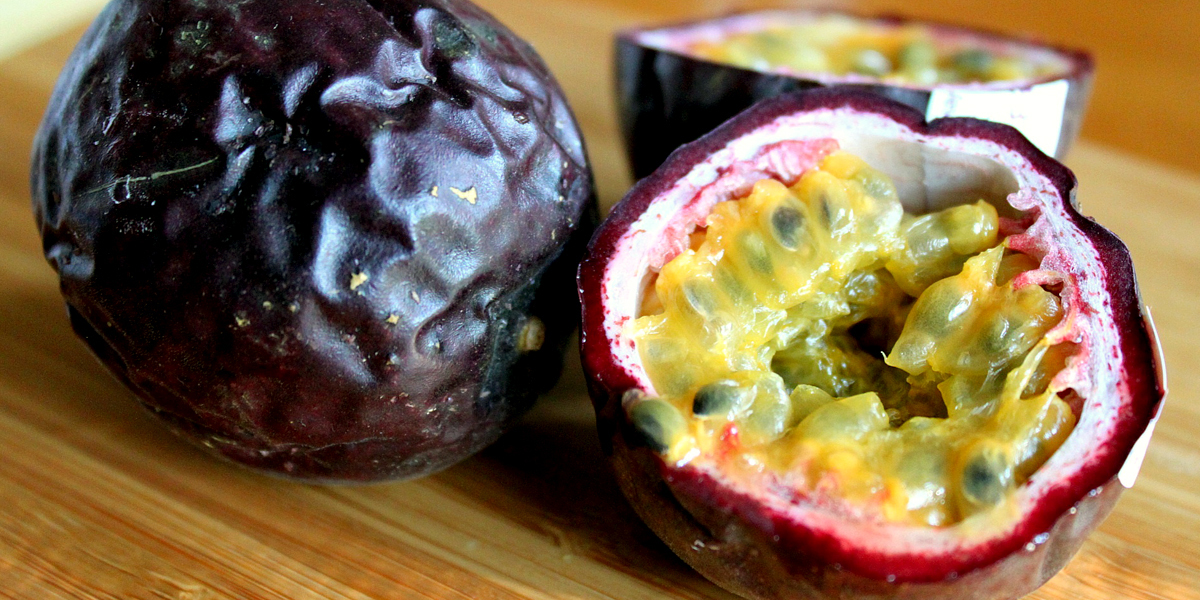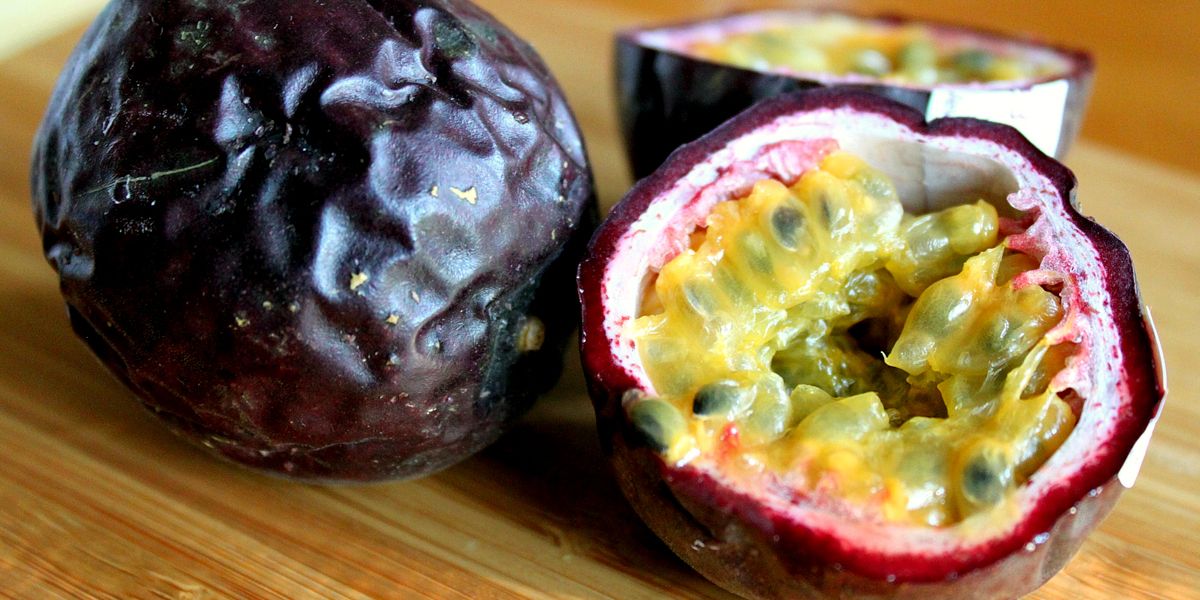

By Helen West
Passion fruit is a nutritious tropical fruit. It’s gaining popularity, especially among those who are health conscious.
Despite its small size, it’s a rich source of antioxidants and contains a range of vitamins and plant compounds that could benefit your health.
This article is a detailed review of passion fruit.
What Is Passion Fruit?
This tropical fruit is actually considered a type of berry. It is the fruit of the Passiflora vine, a type of passion flower.
It has a tough outer rind and juicy, seed-filled center.
There are several types, which can vary in size and color. The most commonly available are the purple and yellow varieties.
These are:
- Passiflora edulis: Small round or oval-shaped fruits with purple skin.
- Passiflora flavicapa: Usually slightly larger than the purple variety, these are round or oval-shaped with yellow skin.
This is what passion fruit looks like:
Although they are a tropical fruit, some varieties can survive in a sub-tropical climate.
Because of this, they are grown all over the world and crops can be found in South and North America, Asia, Europe and Australia.
Bottom Line: Passion fruit is a type of berry grown all over the world. It has a hard, colorful rind and a juicy, seed-filled center.
Passion Fruit Is Highly Nutritious
Passion fruit is a good source of nutrients, especially fiber, vitamin C and vitamin A.
A single purple passion fruit of about 18 grams contains (1):
- Calories: 17
- Fiber: 2 grams
- Vitamin C: 9 percent of the RDI
- Vitamin A: 8 percent of the RDI
- Iron: 2 percent of the RDI
- Potassium: 2 percent of the RDI
This may not seem like much, but these are the values for a single, small fruit that contains only 17 calories. Calorie for calorie, it’s a good source of fiber, vitamin C and vitamin A.
It’s also rich in beneficial plant compounds, including carotenoids and polyphenols.
In fact, one analysis found that passion fruit was richer in polyphenols than many other tropical fruits, including banana, lychee, mango, papaya and pineapple (2).
Additionally, passion fruit contains a small amount of iron.
Your body doesn’t usually absorb iron from plants very well. However, the iron in passion fruit comes with a lot of vitamin C, which is known to enhance iron’s absorption (3).
Bottom Line: Passion fruit is a good source of fiber, vitamin C and vitamin A. Calorie for calorie, it’s a nutrient-dense fruit.
Health Benefits of Passion Fruit
The nutrition profile of passion fruit means it has some great health benefits.
It’s a Rich Source of Antioxidants
Antioxidants protect your body from free radicals, unstable molecules that can damage your cells when they are present in large numbers (4).
Passion fruit contains a lot of antioxidants.
In particular, it’s a rich source of vitamin C, beta-carotene and polyphenols.
Polyphenols are plant compounds that have a range of antioxidant and anti-inflammatory effects. This means they may protect against chronic inflammation and diseases like heart disease and cancer (2, 5, 6).
Vitamin C is an important antioxidant that you need to get from your diet. It helps support a healthy immune system and healthy aging (7, 8, 9, 10, 11).
Beta-carotene is also an important antioxidant. In your body, it is converted to vitamin A, which is essential for preserving good eyesight.
Diets that contain lots of beta-carotenes from plant foods have been linked with a lower risk of some cancers. These include prostate, colon, stomach and breast cancer (12, 13, 14, 15, 16, 17).
It’s a Good Source of Dietary Fiber
A single 18-gram serving of passion fruit contains around 2 grams of fiber, most of which is soluble fiber.
This is quite a large amount for such a small fruit.
Fiber is important for keeping your gut healthy and preventing constipation, yet most people don’t eat enough of it (18).
Soluble fiber helps slow the digestion of your food, which can prevent blood sugar spikes (19).
Diets that are high in fiber are also associated with a lower risk of diseases including heart disease, diabetes and obesity (20).
Bottom Line: Passion fruit is a rich source of antioxidants and dietary fiber. Diets rich in these nutrients have been linked with a lower risk of diseases like heart disease and diabetes.
Passion Fruit Peel Supplement May Help Reduce Inflammation
The high antioxidant content of passion fruit peels may give them powerful anti-inflammatory effects when they’re taken as a supplement.
One small study investigated the effects of a purple passion fruit peel supplement on symptoms of asthma over four weeks (21).
The group who took the supplement experienced a reduction in wheezing, coughing and shortness of breath.
However, this was a very small study, so further research is required before it’s known if this therapy is helpful for those with asthma.
Other research has examined the effects of purple passion fruit peel extract on joint pain and function in people with knee osteoarthritis. This is a painful condition caused by inflammation in the knee joint (22).
The researchers found that people who took the supplement reported less pain and stiffness in their joints than those who didn’t.
Overall, the effects of antioxidants on inflammation and pain in osteoarthritis are still unclear and more research is needed.
Bottom Line: Passion fruit peel supplements may have powerful anti-inflammatory effects. They may be beneficial for people with asthma and osteoarthritis, but more research is required.
Problems With Passion Fruit
Passion fruit is perfectly safe for most people to eat, but allergies do occur in a small number of people.
Those with a latex allergy appear to be most at risk of a passion fruit allergy (23, 24).
This is because some of the plant proteins in the fruit have a similar structure to the latex proteins that can trigger an allergic reaction in some people.
Purple passion fruit skin may also contain chemicals called cyanogenic glycosides. These can combine with enzymes to form the poison cyanide and are therefore potentially poisonous in large amounts (25, 26).
The fruit’s hard outer skin isn’t usually considered edible.
Bottom Line: Passion fruit allergy is rare but some cases do occur. People with a latex allergy are at greater risk.
How to Eat Passion Fruit
To eat this tropical fruit, you need to slice or rip open the rind to expose the colorful, juicy flesh and seeds.
When they are open, passion fruits look like this:
The seeds are edible, so you can eat them together with the colorful flesh and juice.
The white film separating the rind from the flesh is also edible, but most people don’t eat it since it’s very bitter.
Passion fruit is a very versatile fruit and can be used in a variety of ways. Many people enjoy the fruit raw and eat it straight out of the rind.
Some of the more popular ways to use passion fruit include:
- Drinks: It can be squeezed through a sieve to make juice, added to cocktails or used to make a cordial to flavor water, like this.
- Desserts: It is often used as a topping or flavoring for cakes and desserts, like this cheesecake or this mousse.
- On salads: It can be used to add a crunchy texture and sweet flavor to salads like this one.
- In yogurts: Mix it with natural yogurt to make a delicious snack.
Bottom Line: Passion fruit is extremely versatile. You can eat it on its own or add it to drinks, desserts and yogurt. It can also be used to make delicious salad dressings.
Take Home Message
If you’re looking for a nutritious and tasty snack, passion fruit is a great choice.
It’s low in calories and high in nutrients, fiber and antioxidants—all of which make passion fruit an excellent addition to your diet.
Reposted with permission from our media associate Authority Nutrition.

 233k
233k  41k
41k  Subscribe
Subscribe 

